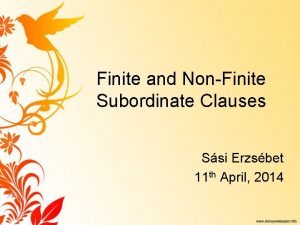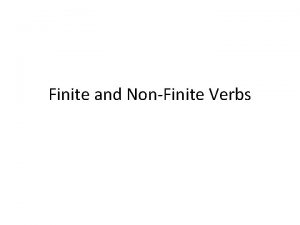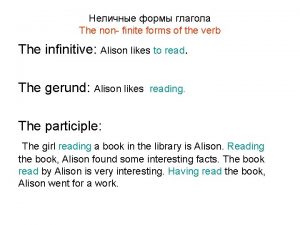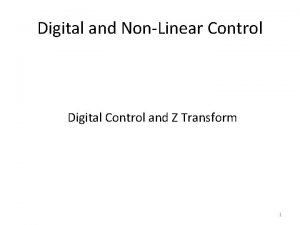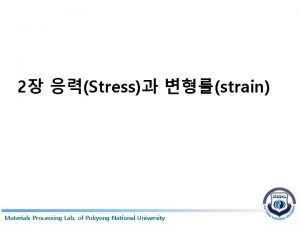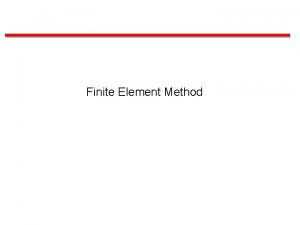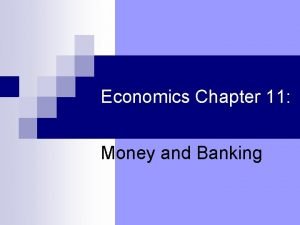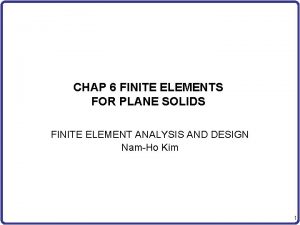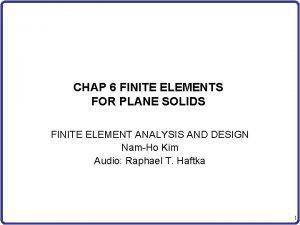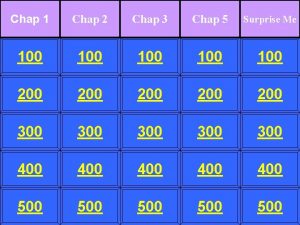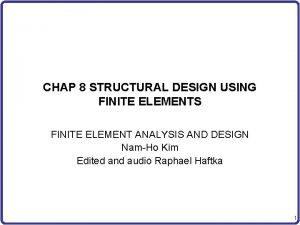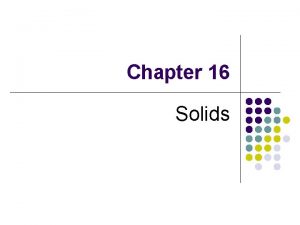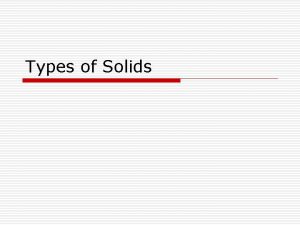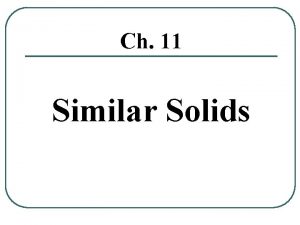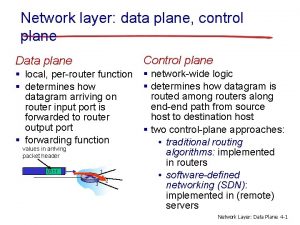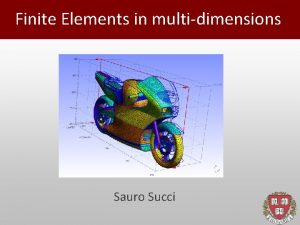CHAP 6 FINITE ELEMENTS FOR PLANE SOLIDS FINITE














- Slides: 14

CHAP 6 FINITE ELEMENTS FOR PLANE SOLIDS FINITE ELEMENT ANALYSIS AND DESIGN Nam-Ho Kim Audio: Raphael T. Haftka 1

INTRODUCTION • Plane Solids – All engineering problems are 3 -D. It is the engineer who approximates the problem using 1 -D (beam or truss) or 2 -D (plane stress or strain). – Stress and strain are either zero or constant in the direction of the thickness. – System of coupled second-order partial differential equation – Plane stress and plane strain: different constraints imposed in the thickness direction – Plane stress: zero stresses in the thickness direction (thin plate with in-plane forces) – Plane strain: zero strains in the thickness direction (thick solid with constant thickness, gun barrel) – Main variables: u (x-displacement) and v (y-displacement) 2

GOVERNING EQUATIONS • Governing D. E. (equilibrium) by bx • Strain-displacement Relation (linear) • Stress-Strain Relation – Since stress involves first-order derivative of displacements, the governing differential equation is the second-order 3

GOVERNING EQUATIONS cont. • Boundary Conditions – All differential equations must be accompanied by boundary conditions – Sg is the essential boundary and ST is the natural boundary – g: prescribed (specified) displacement (usually zero for linear problem) – T: prescribed (specified) surface traction force • Objective: to determine the displacement fields u(x, y) and v(x, y) that satisfy the D. E. and the B. C. 4

PLANE STRESS PROBLEM • Plane Stress Problem: – – Thickness is much smaller than the length and width dimensions Thin plate or disk with applied in-plane forces z-direction stresses are zero at large surfaces (side here) Thus, it is safe to assume that they are also zero along the thickness – Non-zero stress components: σxx, σyy, τxy – Non-zero strain components: εxx, εyy, εxy, εzz Example: Wing skin structure. Why is z stress zero when there is air pressure and friction? What about bending? 5

PLANE STRESS PROBLEM cont. • Stress-strain relation for isotropic material – Even if εzz is not zero, it is not included in the stress-strain relation because it can be calculated from the following relation: • How to derive plane stress relation? – Solve for zz in terms of xx and yy from the relation of zz = 0 and Eq. (1. 57) – Write xx and yy in terms of xx and yy 6

Quiz-like questions • • What are the commonly made assumptions for 2 D solids? What does Sg stand for ? What is the [C] matrix? For plane stress problem in XY plane, what can be said about stress and strain in Z direction? • Answers in notes page 7

PLANE STRAIN PROBLEM • Plane Strain Problem – Thickness dimension is much larger than other two dimensions. – Deformation in the thickness direction is constrained. – Strain in z-dir is zero – Non-zero stress components: σxx, σyy, τxy, σzz. – Non-zero strain components: εxx, εyy, εxy. 8

PLANE STRAIN PROBLEM cont. • Plan Strain Problem – Stress-strain relation – Even if σzz is not zero, it is not included in the stress-strain relation because it can be calculated from the following relation: Limits on Poisson’s ratio 9

EQUIVALENCE • A single program can be used to solve both the plane stress and plane strain problems by converting material properties. From To E Plane strain Plane stress Plane strain 10

PRINCIPLE OF MINIMUM POTENTIAL ENERGY • Strain Energy – energy that is stored in the structure due to the elastic deformation – h: thickness, [C] = [Cσ] for plane stress, and [C] = [Cε] for plane strain. – stress and strain are constant throughout the thickness. – The linear elastic relation {σ} = [C]{ε} has been used in the last relation. 11

PRINCIPLE OF MINIMUM POTENTIAL ENERGY cont. • Potential Energy of Applied Loads – Force acting on a body reduces potential to do additional work. – Negative of product of the force and corresponding displacement – Concentrated forces – Fi and qi are in the same direction – Reaction forces do not have any potential when qi = 0 – Distributed forces (e. g. , pressure load) acting on the edge A ST z y x h {Tx, Ty} 12

PRINCIPLE OF MINIMUM POTENTIAL ENERGY cont. • Total Potential Energy – Net energy contained in the structure – Sum of the strain energy and the potential energy of applied loads • Principle of Minimum Potential Energy – The structure is in equilibrium status when the potential energy has a minimum value. Finite Element Equation – More general to use q’s rather than u’s. 13

Quiz-like questions • Cross section of a long pipe carrying pressurised oil can be modelled using what assumption? • What are the limits on Poisson’s ratio? • For what value of Poisson’s ratio does the material behave as infinitely rigid in shear? • For plane solids, the equation of strain energy gets converted form volume integral to area integral. Why? • What can be said about potential of a force that does not affect any degree of freedom ? • Answers in notes page 14
 Chap chap slide
Chap chap slide Software-defined networking: a comprehensive survey
Software-defined networking: a comprehensive survey Fused relative clause
Fused relative clause Learning objectives for finite and non finite verbs
Learning objectives for finite and non finite verbs Learning objectives of non finite verbs
Learning objectives of non finite verbs How to find finite and nonfinite verbs
How to find finite and nonfinite verbs Finite and non finite
Finite and non finite Forwarding equivalence class (fec)
Forwarding equivalence class (fec) Z-transform examples
Z-transform examples 후크의 법칙
후크의 법칙 Fem
Fem Windbreaker chapter 1
Windbreaker chapter 1 Passion chap 6
Passion chap 6 Bank run chap 11
Bank run chap 11 Durbin chap
Durbin chap


